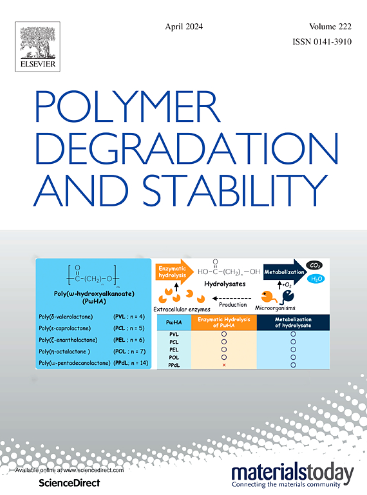Coarse-grained molecular dynamics simulations for oxidative aging of polymers under various O2 concentrations
IF 6.3
2区 化学
Q1 POLYMER SCIENCE
引用次数: 0
Abstract
Modeling of polymer oxidative aging has been actively studied since the 1990s. Insights from these studies suggest that the transport of oxygen and radicals significantly influences aging heterogeneity, alongside chemical reaction kinetics. A recent simulation study [Ishida et al., Macromolecules, 56(21), 8474-8483, 2023] demonstrated that mesoscale heterogeneity arises when the H-abstraction reaction occurs faster than the relaxation times of polymer chains. In this study, the simulations were extended by modeling the rate of oxygen addition to polymer radicals () to reflect the effects of the O₂ concentration. In this work, polypropylene was chosen as a representative example of the target polymer. Three key aspects of oxidative aging behavior were found to be influenced by the O2 addition rate: (i) reaction kinetics, (ii) the degree of heterogeneity, and (iii) amount of crosslinking. Namely, reducing O2 concentration slows the conversion of polymer radicals into H-abstractable peroxyl radicals. This deceleration delays H-abstraction reactions, increases the number of polymer radicals, and promotes crosslinking reactions between two polymer radicals.
不同氧浓度下聚合物氧化老化的粗粒度分子动力学模拟
自20世纪90年代以来,聚合物氧化老化的建模得到了积极的研究。这些研究的见解表明,氧和自由基的运输显著影响衰老的异质性,以及化学反应动力学。最近的一项模拟研究[Ishida等人,Macromolecules, 56(21), 8474-8483, 2023]表明,当h萃取反应发生的速度快于聚合物链的弛豫时间时,中尺度非均质性就会出现。在本研究中,通过模拟氧对聚合物自由基的加成速率(k2)来扩展模拟,以反映O₂浓度的影响。在这项工作中,选择聚丙烯作为目标聚合物的代表性例子。发现氧化老化行为的三个关键方面受到O2添加速率的影响:(i)反应动力学,(ii)异质性程度,(iii)交联量。也就是说,降低O2浓度减缓了聚合物自由基向h可提取的过氧自由基的转化。这种减速延迟了吸氢反应,增加了聚合物自由基的数量,并促进了两个聚合物自由基之间的交联反应。
本文章由计算机程序翻译,如有差异,请以英文原文为准。
求助全文
约1分钟内获得全文
求助全文
来源期刊

Polymer Degradation and Stability
化学-高分子科学
CiteScore
10.10
自引率
10.20%
发文量
325
审稿时长
23 days
期刊介绍:
Polymer Degradation and Stability deals with the degradation reactions and their control which are a major preoccupation of practitioners of the many and diverse aspects of modern polymer technology.
Deteriorative reactions occur during processing, when polymers are subjected to heat, oxygen and mechanical stress, and during the useful life of the materials when oxygen and sunlight are the most important degradative agencies. In more specialised applications, degradation may be induced by high energy radiation, ozone, atmospheric pollutants, mechanical stress, biological action, hydrolysis and many other influences. The mechanisms of these reactions and stabilisation processes must be understood if the technology and application of polymers are to continue to advance. The reporting of investigations of this kind is therefore a major function of this journal.
However there are also new developments in polymer technology in which degradation processes find positive applications. For example, photodegradable plastics are now available, the recycling of polymeric products will become increasingly important, degradation and combustion studies are involved in the definition of the fire hazards which are associated with polymeric materials and the microelectronics industry is vitally dependent upon polymer degradation in the manufacture of its circuitry. Polymer properties may also be improved by processes like curing and grafting, the chemistry of which can be closely related to that which causes physical deterioration in other circumstances.
 求助内容:
求助内容: 应助结果提醒方式:
应助结果提醒方式:


